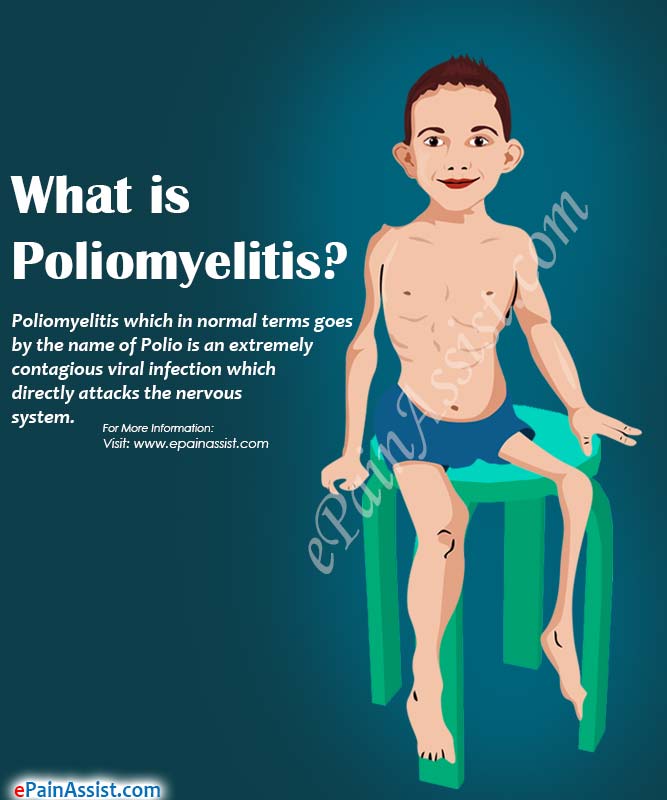What is Poliomyelitis?
Poliomyelitis which in normal terms goes by the name of Polio is an extremely contagious viral infection which directly attacks the nervous system. This virus usually attacks children below the age of 5 years. Once a deadly disease, with the advances made by medical science most of the countries around the world have been declared Poliomyelitis free, except for a few backward nations in the Asian and African continents.
Poliomyelitis is an extremely serious disease condition that makes a child paralyzed on one side of the body permanently by damaging the nervous system. Fortunately, with increased awareness of the people and the various educational programs organized by governments of various countries around the world the demon of Poliomyelitis has been eradicated almost everywhere around the world. Poliomyelitis in the United States is now extremely uncommon and rare with almost all children being vaccinated from this disease called Poliomyelitis.

What Causes Poliomyelitis?
As stated, Poliomyelitis is caused by the Poliovirus. This virus can infect a child through contact with the feces. Certain objects like toys that may have come in contact with infected feces can transmit the virus to the child. Coming in close contact with an individual who might have been infected may also cause Poliomyelitis through a cough or a sneeze although this is less common.
Poliomyelitis is usually seen in people living in unhygienic conditions where clean drinking water and hygienic toilets are a scarcity. The people drink water which may have been contaminated by human waste and get infected with Poliomyelitis. The people most at risk for getting Poliomyelitis are pregnant women, children under 5 years of age who have not been vaccinated for Poliomyelitis, people with compromised immune system, people suffering from conditions like HIV/AIDS.
Thus it is essential for everyone to be vaccinated for Poliomyelitis if they are planning to travel in countries where they have to encounter unhygienic living situations to prevent them from contacting Poliomyelitis.
What are the Symptoms of Poliomyelitis?
Despite Poliomyelitis being an extremely serious medical condition, majority of the cases of Poliomyelitis are asymptomatic even though they can still spreads the virus. There are basically three types of Poliomyelitis, nonparalytic, paralytic, and postpolio syndrome. All these three variations have different set of symptoms delineated below:
Nonparalytic Polio: The symptoms of this form of Poliomyelitis are:
- Fever
- Sore throat
- Frequent headaches
- Vomiting
- Fatigue
- Meningitis
- These symptoms may last for up to about a week
Paralytic Poliomyelitis: The symptoms of this form of Poliomyelitis are:
This form of Poliomyelitis is quite rare and affects about 1% of the cases of Poliomyelitis. This may lead to paralysis of the spinal cord, brainstem, or both. Initially the symptoms are similar to nonparalytic Poliomyelitis but as the disease advances more symptoms start to appear and include:
- Loss of reflexes
- Muscle pain
- Floppy limbs on one or both sides of the body
- Sudden paralysis, on one side or both which may be temporary or permanent
- Limb deformity especially of the hips, ankles, and feet.
A complete or full paralysis is very rare. In about 10% of the cases of Poliomyelitis, the virus attacks the muscles that assist in breathing and may prove fatal for the patient.
Postpolio Syndrome: In some cases after a patient has recovered from Poliomyelitis, after a decade or two of his or her life the symptoms tend to recur. This is what is termed as Postpolio Syndrome. Some of the symptoms of this condition are:
- Persistent muscle and joint weakness
- Worsening muscle pain
- Getting exhausted with minimal activity
- Muscle wasting
- Problems with breathing
- Dysphagia
- Sleep apnea
- Depression
- Problems with memory.
It is estimated that about 30% of people who have had Poliomyelitis in the past may get this syndrome. It is recommended to consult primary care physician if any of these symptoms develop and there is a remote history of Poliomyelitis.
How is Poliomyelitis Treated?
Poliomyelitis is a disease condition that can be prevented but not cured thus prevention is the way to treat Poliomyelitis. In case if an individual gets Poliomyelitis then the best way to treat is to treat the symptoms and allow the infection to run its course.
Some of the ways to treat the symptoms of Poliomyelitis are:
- Quarantine the patient to prevent risk of others getting infected
- Complete bedrest till the symptoms improve
- Pain medications for treating pain associated with Poliomyelitis
- Antispasmodics for muscle tightness and spasms associated with Poliomyelitis
- Antibiotics for urinary tract infections associated with Poliomyelitis
- In case if the respiratory system gets affected then ventilatory system may be required to assist in breathing till the patient is able to breathe normally once the infection runs its course
- Aggressive physical therapy to treat muscle weakness and allow the patient to function more normally and independently after Poliomyelitis
- Physical therapy may also be effective for problems associated with breathing as a result of Poliomyelitis affecting the respiratory system
- For cases of paralysis affecting the lower extremities an assistive device may be required either temporarily or permanently depending on the severity of Poliomyelitis.
- World Health Organization (WHO) – Poliomyelitis (polio): https://www.who.int/news-room/fact-sheets/detail/poliomyelitis
- Centers for Disease Control and Prevention (CDC) – Polio: https://www.cdc.gov/polio/index.htm
- Mayo Clinic – Polio: https://www.mayoclinic.org/diseases-conditions/polio/symptoms-causes/syc-20376512
- MedlinePlus – Polio and Post-Polio Syndrome: https://medlineplus.gov/polioandpostpoliosyndrome.html
Also Read:
